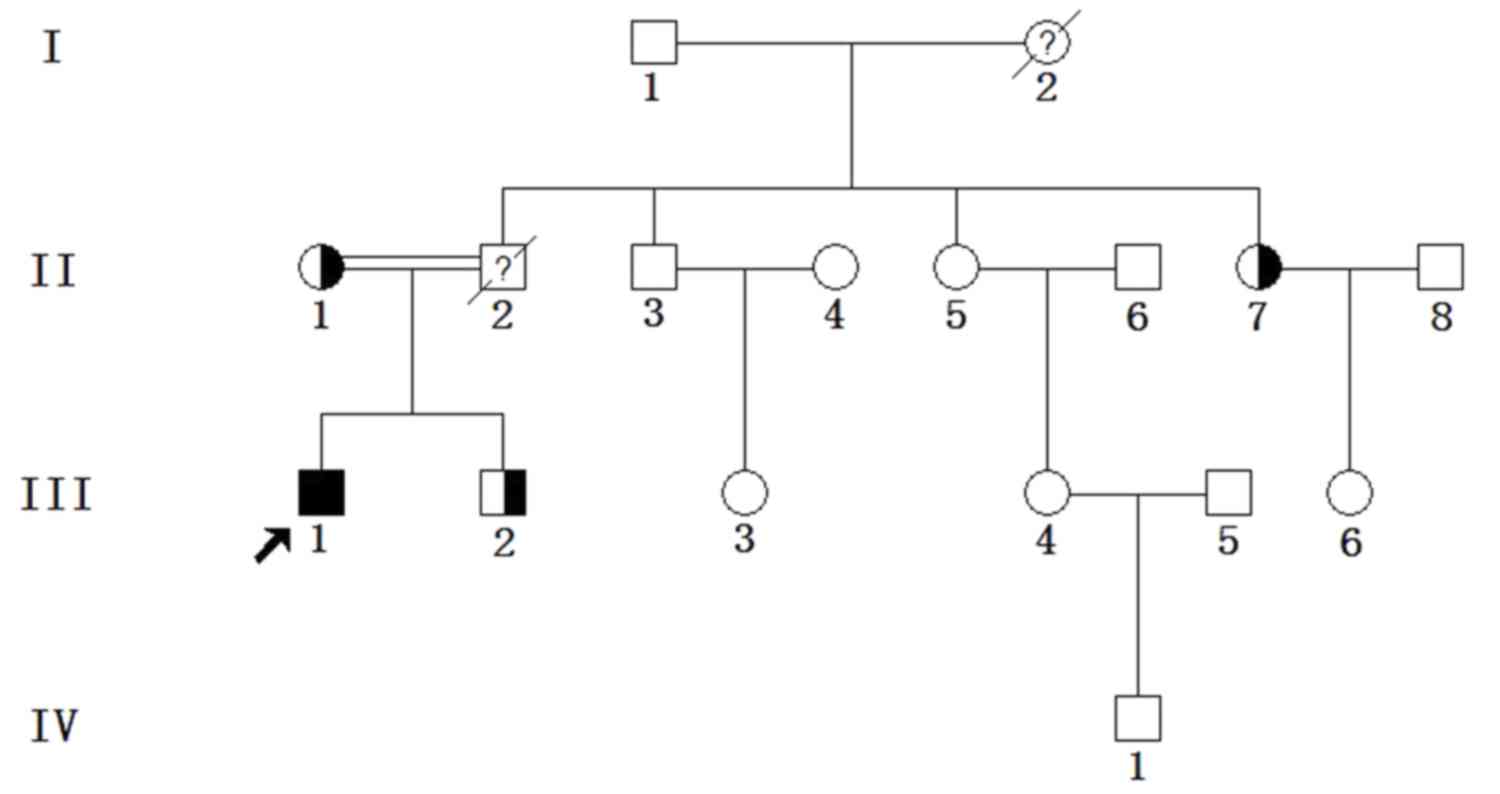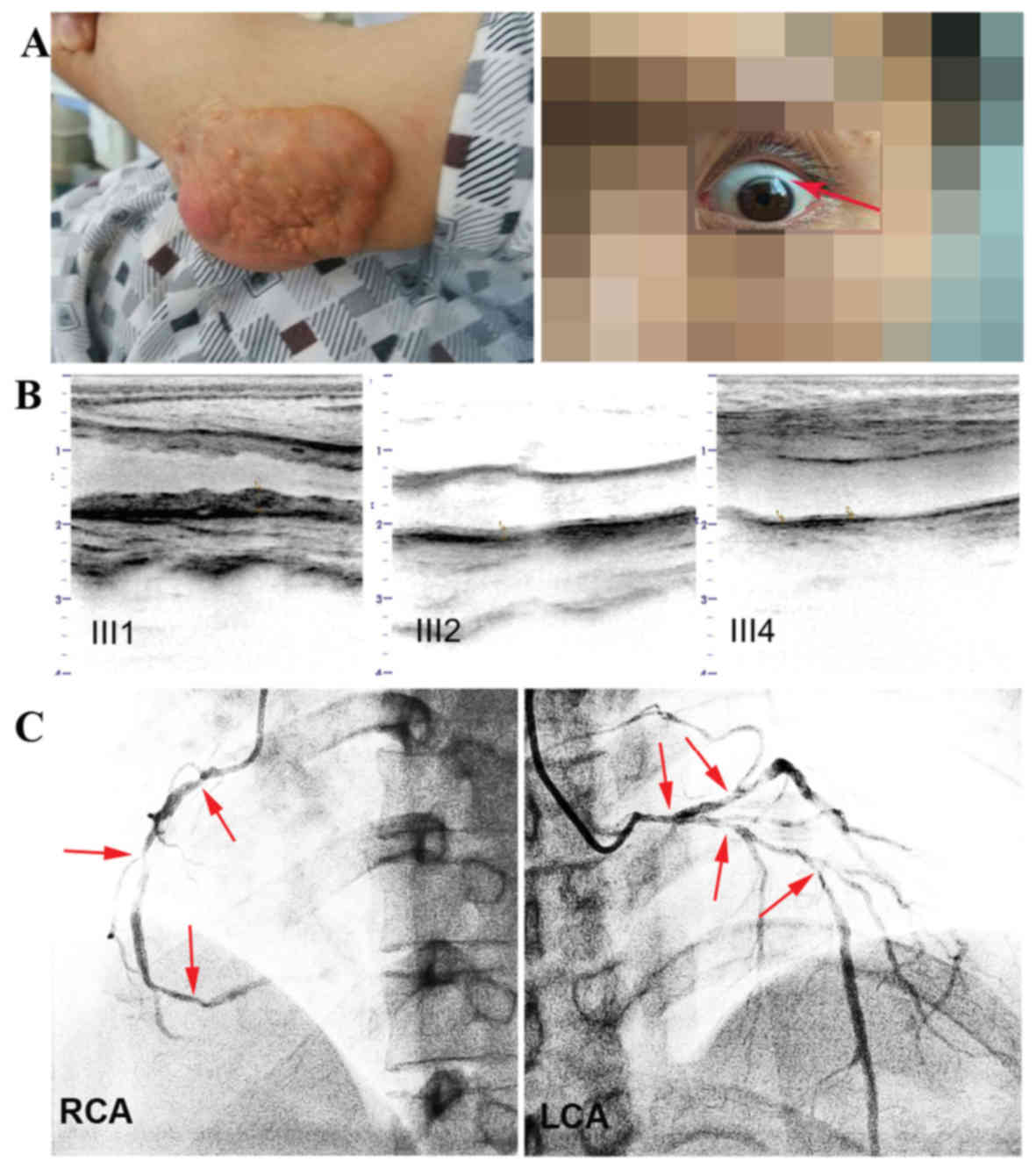|
1
|
Hopkins PN, Toth PP, Ballantyne CM and
Rader DJ; National Lipid Association Expert Panel on Familial
Hypercholesterolemia: Familial hypercholesterolemias: Prevalence,
genetics, diagnosis and screening recommendations from the National
Lipid Association Expert Panel on Familial Hypercholesterolemia. J
Clin Lipidol. 5(3 Suppl): S9–S17. 2011. View Article : Google Scholar : PubMed/NCBI
|
|
2
|
Raal FJ and Santos RD: Homozygous familial
hypercholesterolemia: Current perspectives on diagnosis and
treatment. Atherosclerosis. 223:262–268. 2012. View Article : Google Scholar : PubMed/NCBI
|
|
3
|
van der Graaf A, Avis HJ, Kusters DM,
Vissers MN, Hutten BA, Defesche JC, Huijgen R, Fouchier SW, Wijburg
FA, Kastelein JJ and Wiegman A: Molecular basis of autosomal
dominant hypercholesterolemia: Assessment in a large cohort of
hypercholesterolemic children. Circulation. 123:1167–1173. 2011.
View Article : Google Scholar : PubMed/NCBI
|
|
4
|
Tada H, Kawashiri MA, Ohtani R, Noguchi T,
Nakanishi C, Konno T, Hayashi K, Nohara A, Inazu A, Kobayashi J, et
al: A novel type of familial hypercholesterolemia: Double
heterozygous mutations in LDL receptor and LDL receptor adaptor
protein 1 gene. Atherosclerosis. 219:663–666. 2011. View Article : Google Scholar : PubMed/NCBI
|
|
5
|
Mabuchi H, Nohara A, Noguchi T, Kobayashi
J, Kawashiri MA, Inoue T, Mori M, Tada H, Nakanishi C, Yagi K, et
al: Genotypic and phenotypic features in homozygous familial
hypercholesterolemia caused by proprotein convertase
subtilisin/kexin type 9 (PCSK9) gain-of-function mutation.
Atherosclerosis. 236:54–61. 2014. View Article : Google Scholar : PubMed/NCBI
|
|
6
|
Rader DJ, Cohen J and Hobbs HH: Monogenic
hypercholesterolemia: New insights in pathogenesis and treatment. J
Clin Invest. 111:1795–1803. 2003. View Article : Google Scholar : PubMed/NCBI
|
|
7
|
Goldberg AC, Hopkins PN, Toth PP,
Ballantyne CM, Rader DJ, Robinson JG, Daniels SR, Gidding SS, de
Ferranti SD, Ito MK, et al: Familial hypercholesterolemia:
Screening, diagnosis and management of pediatric and adult
patients: Clinical guidance from the National Lipid Association
Expert Panel on Familial Hypercholesterolemia. J Clin Lipidol. 5(3
Suppl): S1–S8. 2011. View Article : Google Scholar : PubMed/NCBI
|
|
8
|
University College London (UCL): LDLR FH
database. http://www.ucl.ac.uk/ldlr/Current/index.php?select_db=LDLRSeptember
14–2015
|
|
9
|
Soutar AK and Naoumova RP: Mechanisms of
disease: Genetic causes of familial hypercholesterolemia. Nat Clin
Pract Cardiovasc Med. 4:214–225. 2007. View Article : Google Scholar : PubMed/NCBI
|
|
10
|
Anderson RG: Joe Goldstein and Mike Brown:
From cholesterol homeostasis to new paradigms in membrane biology.
Trends Cell Biol. 13:534–539. 2003. View Article : Google Scholar : PubMed/NCBI
|
|
11
|
Mak YT, Pang CP, Tomlinson B, Zhang J,
Chan YS, Mak TW and Masarei JR: Mutations in the low-density
lipoprotein receptor gene in Chinese familial hypercholesterolemia
patients. Arterioscler Thromb Vasc Biol. 18:1600–1605. 1998.
View Article : Google Scholar : PubMed/NCBI
|
|
12
|
Shi Z, Yuan B, Zhao D, Taylor AW, Lin J
and Watts GF: Familial hypercholesterolemia in China: Prevalence
and evidence of underdetection and undertreatment in a community
population. Int J Cardiol. 174:834–836. 2014. View Article : Google Scholar : PubMed/NCBI
|
|
13
|
Fan LL, Lin MJ, Chen YQ, Huang H, Peng DQ,
Xia K, Zhao SP and Xiang R: Novel mutations of low-density
lipoprotein receptor gene in china patients with familial
hypercholesterolemia. Appl Biochem Biotechnol. 176:101–109. 2015.
View Article : Google Scholar : PubMed/NCBI
|
|
14
|
Desaphy JF, Gramegna G, Altamura C,
Dinardo MM, Imbrici P, George AL Jr, Modoni A, Lomonaco M and Conte
Camerino D: Functional characterization of ClC-1 mutations from
patients affected by recessive myotonia congenita presenting with
different clinical phenotypes. Exp Neurol. 248:530–540. 2013.
View Article : Google Scholar : PubMed/NCBI
|
|
15
|
Moosa MM, Ayub MI, Bashar AE, Sarwardi G,
Khan W, Khan H and Yeasmin S: Combination of two rare mutations
causes β-thalassaemia in a Bangladeshi patient. Genet Mol Biol.
34:406–409. 2011. View Article : Google Scholar : PubMed/NCBI
|
|
16
|
Kasana BA, Dar WR, Aziz SA, Lone AR, Sofi
NU, Dar IA, Latief M, Arshad F and Hussain M and Hussain M:
Epidermal growth factor receptor mutation in adenocarcinoma lung in
a North Indian population: Prevalence and relation with different
clinical variables. Indian J Med Paediatr Oncol. 37:189–195. 2016.
View Article : Google Scholar : PubMed/NCBI
|
|
17
|
Loparev VN, Cartas MA, Monken CE, Velpandi
A and Srinivasan A: An efficient and simple method of DNA
extraction from whole blood and cell lines to identify infectious
agents. J Virol Methods. 34:105–112. 1991. View Article : Google Scholar : PubMed/NCBI
|
|
18
|
Cheng X, Ding J, Zheng F, Zhou X and Xiong
C: Two mutations in LDLR gene were found in two Chinese families
with familial hypercholesterolemia. Mol Biol Rep. 36:2053–2057.
2008. View Article : Google Scholar : PubMed/NCBI
|
|
19
|
Li H, Zhang Y, Wei X, Peng Y, Yang P, Tan
H, Chen C, Pan Q, Liang D and Wu L: Rare intracranial cholesterol
deposition and a homozygous mutation of LDLR in a familial
hypercholesterolemia patient. Gene. 569:313–317. 2015. View Article : Google Scholar : PubMed/NCBI
|
|
20
|
Mothobi ME, Guo S, Liu Y, Chen Q, Yussuf
AS, Zhu X and Fang Z: Mutation analysis of congenital cataract in a
Basotho family identified a new missense allele in CRYBB2. Mol Vis.
15:1470–1475. 2009.PubMed/NCBI
|
|
21
|
Chen Q, Ma J, Yan M, Mothobi ME, Liu Y and
Zheng F: A novel mutation in CRYAB associated with autosomal
dominant congenital nuclear cataract in a Chinese family. Mol Vis.
15:1359–1365. 2009.PubMed/NCBI
|
|
22
|
Yan M, Xiong C, Ye SQ, Chen Y, Ke M, Zheng
F and Zhou X: A novel connexin 50 (GJA8) mutation in a Chinese
family with a dominant congenital pulverulent nuclear cataract. Mol
Vis. 14:418–424. 2008.PubMed/NCBI
|
|
23
|
Hovingh GK, Davidson MH, Kastelein JJ and
O'Connor AM: Diagnosis and treatment of familial
hypercholesterolaemia. Eur Heart J. 34:962–971. 2013. View Article : Google Scholar : PubMed/NCBI
|
|
24
|
Goldstein JL and Brown MS: The LDL
receptor. Arterioscler Thromb Vasc Biol. 29:431–438. 2009.
View Article : Google Scholar : PubMed/NCBI
|
|
25
|
Davis CG, Goldstein JL, Südhof TC,
Anderson RG, Russell DW and Brown MS: Acid-dependent ligand
dissociation and recycling of LDL receptor mediated by growth
factor homology region. Nature. 326:760–765. 1987. View Article : Google Scholar : PubMed/NCBI
|
|
26
|
Yao RE, Wang J, Geng J, Zheng Z, Yu T, Yu
Y and Fu Q: Identification of LDLR mutations in two Chinese
pedigrees with familial hypercholesterolemia. J Pediatr Endocrinol
Metab. 25:769–773. 2012. View Article : Google Scholar : PubMed/NCBI
|
|
27
|
Sun XM, Patel DD, Webb JC, Knight BL, Fan
LM, Cai HJ and Soutar AK: Familial hypercholesterolemia in China.
Identification of mutations in the LDL-receptor gene that result in
a receptor-negative phenotype. Arterioscler Thromb. 14:85–94. 1994.
View Article : Google Scholar : PubMed/NCBI
|
|
28
|
Hobbs HH, Brown MS and Goldstein JL:
Molecular genetics of the LDL receptor gene in familial
hypercholesterolemia. Hum Mutat. 1:445–466. 1992. View Article : Google Scholar : PubMed/NCBI
|
|
29
|
Boright AP, Connelly PW, Brunt JH, Morgan
K and Hegele RA: Association and linkage of LDLR gene variation
with variation in plasma low density lipoprotein cholesterol. J Hum
Genet. 43:153–159. 1998. View Article : Google Scholar : PubMed/NCBI
|
|
30
|
Yamada Y, Ichihara S, Kato K, Yoshida T,
Yokoi K, Matsuo H, Watanabe S, Metoki N, Yoshida H, Satoh K, et al:
Genetic risk for metabolic syndrome: Examination of candidate gene
polymorphisms related to lipid metabolism in Japanese people. J Med
Genet. 45:22–28. 2008. View Article : Google Scholar : PubMed/NCBI
|














